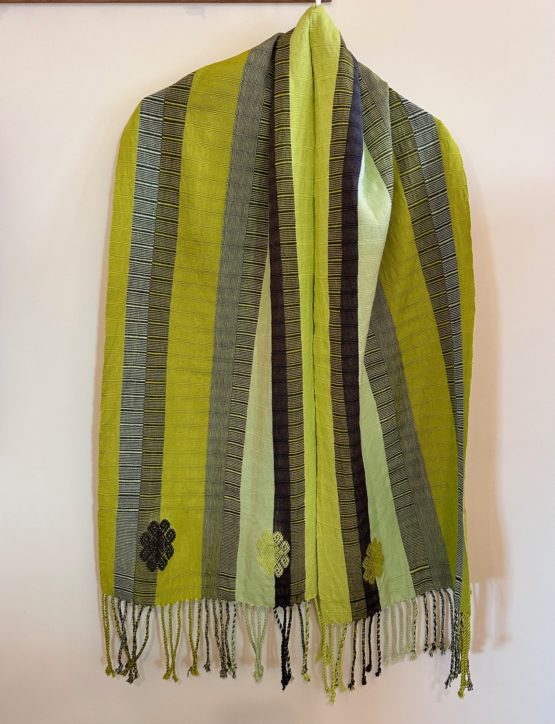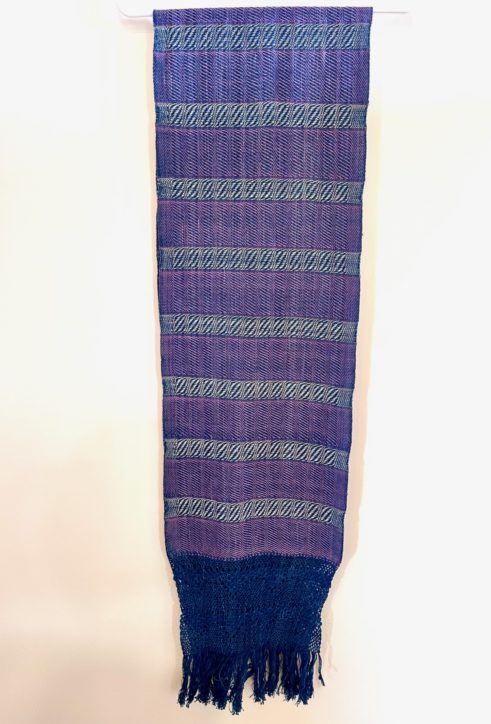One of my first outings after settling into my casita in Teotitlan del Valle upon arrival to Oaxaca was to make a visit to weaver Arturo Hernandez in San Pablo Villa de Mitla. Mitla is one of those ancient Zapotec villages where a spectacular archeological site rises from the landscape of wild agave, cactus and a mountain backdrop. It was originally known at Mictlan (translates to Place of the Dead). The Spanish couldn’t pronounce it, so it became Mitla.) This time of year wild marigold dots the horizon with a sea of yellow flowers that the ancestors used to decorate altars in honor of loved ones — a pre-Hispanic tradition that blended into Dia de los Muertos. Because Zapotec royalty were interred here, the town goes all out for Day of the Dead traditions.

Arturo has been a friend for many, many years. He is one of those few weavers remaining in Mitla who uses the back-strap loom to create wool cloth that becomes ponchos and blankets. (He also works in cotton on the pedal loom.) This loom is wider and heavier than the traditional back-strap loom for cotton, and is used by men in a standing position. They sway back-and-forth to control the tension, one end tied to a post, the other around their waist.

The traditional pattern woven in Mitla includes symbols of corn, cacao and the plumed serpent — all important in Zapotec mythology and prayers for fertility and food. Arturo has the distinction of also working with natural dyes. His pieces are spectacular examples of textiles colored with cochineal, indigo, wild marigold, zapote negro (a local fruit), and pecan shells. Over-dyes yield purple, pink, and green.

The village of Mitla, a Pueblo Magico, is about five miles from Santiago Matatlan that bills itself as the Mezcal Capital of the World. Corn fields have given way to neat rows of espadin agave, the fastest growing of all plants used for mezcal, that are ripe after seven years. Traditional farmers of the milpas: corn, squash, and beans are forgoing these crops to plant agave. As demand rises rapidly, this cash crop has become a favored way of making big, fast money. Who can blame them?

I’m standing in a long line at the airport to buy a shuttle ticket to town. In front of me are two young men, 30-somethings. When I ask, they say they are from Denver. How long will you be here? I say. Four days, they answer. What will you do here for four days? I continue. We plan to drink a lot of mezcal, they say. This is the story of Oaxaca today. Mezcal. The men decided to come to Oaxaca instead of going to Chattanooga for a friend’s wedding. Why? Because the airline cost to Tennessee was too high! Go figure. I ask them if they know anything about the culture? Will they visit Monte Alban or any of the nearby Zapotec artisan villages? Hmmm. They hadn’t thought of that. This is the story of Oaxaca today. Mezcal.

So, Arturo says to me, I don’t have enough weavers. I’m down to one. No one wants to work the traditional looms. They are all going to the agave fields where they can make 400 pesos a day. That’s $20 USD, folks. Considered a good wage here. So, my observation is that labor for traditional craft and artisan work will become more scarce in the Tlacolula Valley. I ask Arturo what he pays his workers. About the same, he says. But, I see this is repetitive work to stand at a flying shuttle pedal loom all day, throwing the shuttle back and forth across the warp threads, manipulating the design with your feet. Whereas in the agave fields, one can move and breathe the fresh air.

There’s another factor at play here that has a huge impact on the environment and sustainability. Arturo says that herbicides and pesticides are now widely used in the agave fields. He says this is no longer artisanal, even though the marketing people claim otherwise. He sees men carrying the tanks on their backs, spraying the earth to eradicate the weeds that come up between the rows. The edible wild plants eaten by the ancestors, like quelites, are supressed. The insects and animals that aerate the earth are wiped clean. The plants will grow faster and bring a larger yield.

I think a lot about the rise of mezcal as a favored distilled beverage. Of course, I love it! Especially the wild agaves like tepeztate, madrecuishe, and arroqueño. It takes a longer time for these varieties to mature, some as much as twenty-five years, which makes the cost so much higher. As the wild varieties are used up, the mezcaleros (mezcal makers) are now reproducing them as cultivars. So, technically, they may no longer be wild, absorbing the flavors of the earth from a specific rocky outcropping of land. Mezcal making is a complex art much like wine making. It is NOT tequila!

So, what will happen to Arturo and his weaving studio if there is no one who wants to work the looms? Is our Oaxaca artisan craft on the verge of extinction, much like the Emperor Penguins of Antarctica.
What will you do and what will you learn when you come to Oaxaca? Isn’t the story of Oaxaca more than mezcal?














Tlacolula Market Christmas Preview: Oaxaca Glitters
I grew up in Tinseltown. My memory is imprinted with pink, blue and white flocked Christmas trees for sale on pop-up corner lots along Ventura Boulevard in the San Fernando Valley of Los Angeles. Glitter was not only reserved for Hollywood. Garlands of sparkling silver ropes and plastic poinsettias could make any California dream of snowmen come true even in sunny December.
Checking email, texting or whatever — Tlacolula, Oaxaca, Mexico
Little did we know that poinsettias, called nochebuena here, are native to Mexico, bloom in November and December, have become the North American symbol for Christmas. They are all over town.
Welcome to Tlacolula, Oaxaca, Mexico, where traditional Mexican Christmas decorations of moss and bromeliads mingle with shiny stars, dangling bulbs, plastic farm animals and colored Christmas trees — a cross-cultural holiday morphing that points to the immigration back and forth across the border (sorry, Donald Trump). And it’s sunny here, too. Sometimes downright hot in December.
Everything you’d ever need to decorate for Christmas
Evoking Frida Kahlo: Making Memory Altars and Shrines, February 25-28, 2016
So many of Mexican parentage are United States of American citizens and they come home to visit family this season. We can debate the impact of change and commercialism on the culture of indigenous Mexico and what the word authentic means. People come back together after being separated and that in itself is good news.
Bromeliads from the Sierra Juarez, traditional decorations
(Don’t forget, Donald Trump, that Mexicans have lived in the United States for over 400 years, and that the southwest was stolen from Mexico in a trumped up war to gain territory.)
Poinsettias that are planted in tierra firma bloom here every holiday season — a natural part of the environment. So, there’s no excuse for fake here, although I see plenty of imported from China nochebuena flowers sticking out of vases on restaurant tabletops.
A 30-lb. turkey (or more) at 1,300 MXN pesos, led on a string
Those who can afford it will have turkey — pavo, guajolote — on their Christmas table. This will usually be dressed with mole negro or mole amarillo, depending on family tradition. There were plenty of live turkeys for sale on this Tlacolula market day, the last one before Christmas. The ladies were vying for customers.
The poultry sellers market, Tlacolula, Oaxaca
I could hardly get through the crowds, even at my usual 10:30 a.m. arrival time when typically there are fewer people. The crowds don’t usually come until after noon. But, the aisles were jammed with vendors, either stationary at tables or sitting on mats, or trying to move rolling carts from one spot to another.
Couple this with families out shopping for Christmas gifts and visitors from the city and you can imagine the skill required to negotiate the camino without tripping over someone or getting stepped on.
Fancy day-glow tennis shoes, a perfect Christmas gift
What I noticed most were a different variety of displays this time of year destined to become gifts: day-glow socks, lacy underwear, art work, fleecy hats, piles of oranges, embroidered little girl dresses and fancy tennis shoes.
Mamay fruit also known as Zapote Chico
Wall decor for holiday giving, some original, some reproductions
Plus, lots of fireworks for sale. Pyrotechnics are a big deal here and kids love shooting off firecrackers and spinners. Are they regulated? Heck, no.
Waiting in line for remittances, Tlacolula, Oaxaca, Mexico
The line out in front of the money exchange was a block long all day long. People were waiting to collect the remittance dollar being sent from the U.S.A. by family members who are there working for the benefit of those at home. Since the exchange rate is now over 17 MXN pesos to the dollar, this is a Christmas bonus for many in the Tlacolula Valley.
Tourists love it, too. This is an especially good time to go shopping in Mexico. I noticed the market had more than its share of gringo travelers. Let’s hope they left with some treasures and left their pesos behind.
Oil paintings and watercolors for sale on Tlacolula street, kitsch folk art
Piñatas for Christmas? Yes, it’s someone’s birthday!
I am waiting for my family to arrive this week for holiday celebrations. We are going on a Collectivo 1050 Degrados tour to Atzompa tomorrow, a mezcal tour next week, maybe a visit to Hierve el Agua and a stop in Mitla on the way back. It’ll be busy, but I’ll try to keep up with Oaxaca comings and goings.
Packed parking lot — first time in my memory here.
Like this:
6 Comments
Posted in Cultural Commentary, Mexican Immigration, Mexico, Photography, Travel & Tourism
Tagged Christmas, decorations, gifts, guajolote, labor, market, Mexico, nochebuena, Oaxaca, poinsettia, remittances, Sunday, Tlacolula, turkey